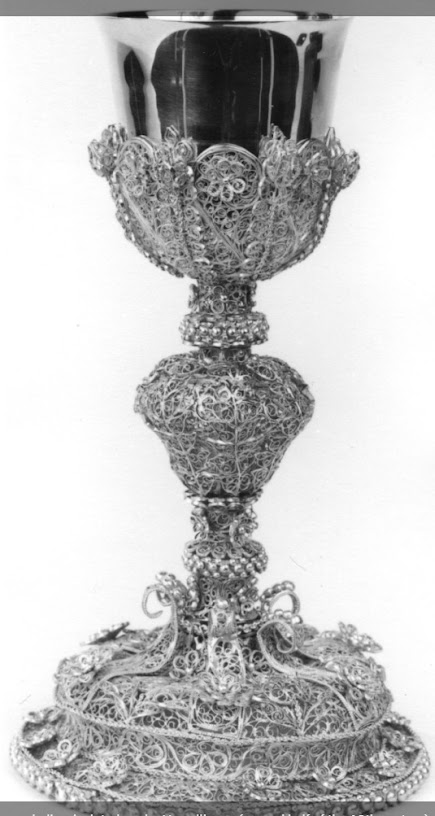A Truly Spectacular Shell Shaped Sardonyx Bowl,
mounted with Enamelled, Gold Filigree.
Possibly Italian - Milan or Florentine Workshop.
Green Vault / Grunes Gewolbe, Dresden.
17th Century.
Post in preparation.
updated 3 May 2023.
It is first mentioned in the Inventory of the Precious Room
of the Green Vault, 1725, fol. 5 r-v.
The inventory of 1879 tells us: "Eine ovale gemuschelte
Schale von orientalischen Sardonyx, mit goldener Filigran-Arbeit, die mit bunt
emaillirten Blumen besetzt ist, eingefaßt. Hinten auf der Muschel ist ein
dergleichen Baldachin, unter welchem eine kleine, goldene und emaillirte Büste
eines Mohren sich befindet. Der Angriff und der eckige Fuß sind von gleicher
Filigran-Arbeit mit emaillirten Blumen."
This roughly translates as "An oval shell of oriental sardonyx set with gold filigree work set with multicolored enameled flowers. At the back of the shell is a similar canopy, under which is a small golden and enameled bust of a Moor. The attack and the square foot are of the same filigree work with enameled flowers."
The Sardonyx was probably mined in Germany or what is now the Czech Republic

H. 19.0cm, W. 16.4cm, 12.3cm; foot W 16.2 cm.
I am very grateful to Dirk Weber, Curator at the Green Vault for pointing this piece out to me and providing these photographs of this truly remarkable object.
https://skd-online-collection.skd.museum/Details/Index/117886
________________
Libation Cup made from Rhinoceros Horn, goblet: China,
Ming dynasty, early 17th century, mount:
Kunsthistorische Museum, Vienna.
From the 2010 Exhibition Splendour & Power.
Imperial Treasures from Vienna at the Fitzwilliam Museum, Cambridge.
This object has in the past been described as Chinese but from the style of the mount I suggest that whilst thew cup is obviously Chinese the mount is European (it should be compared with the filigree mount (particularly on the base) on the Sardonyx bowl at the Grunes Gewolbe illustrated above.
____________
Another Rhinoceros Horn Cup - Mounted with Gold Filigree.
This work is part of the inheritance received by King Felipe
V (1683-1746) on the death of his father, the Great Dauphin, in 1712.
Attributed to the workshop of Giovanni Battista Metellino, of Milan (active late 17th Century to 1722/3)
The Museo del Prado has the photograph by Juan Laurent y
Minier, Tasse ovale, anses en or ciselé et soucoupe, agate cornaline, montures
d’argent doré et filigranes, XVIe siècle, règne de Henri III, c. 1879. Museo
del Prado, HF0835/17.
This tazza must have been very similar to another one that vanished in 1815, inventoried with the number I1401, whose handles, also of filigree, were enriched with garnets. Both were given to the Dauphin by the Comte de Tessé.
It is possible that the agate platter with a cruciform motif at
the Prado, O63, featured similar work, since its leather case resembles that of the
other two pieces.
Mounts similar to those which adorned this tazza at the
Prado are found on a documented Milanese piece, a eucharistic casket donated to
the College of San Bartolomé in Salamanca by Don Pedro Pacheco y Navarrete, who
was a senator in Milan and governor of Cremona. Published by Valdovinos, the
work is adorned with scrolls similar to those seen in Laurent’s photograph,
taken when the Prado tazza was still complete. In this connection, the
extraordinary Papal Nuncio had given the Prado’s platter O63 to the Dauphin in
1702, along with another tazza with which it formed a set, and which was not
inherited by Philip V. The Museo Poldi Pezzoli in Milan preserves examples of
low tazzas with filigree mounting similar to the piece discussed here, such as
inv. no. 540 (no. 270 of the clock and silver collection).
This bowl has definite similarities with a group of bowls
from the Medici Treasures preserved in the Museo degli Argenti in Florence,
some of which come from the legacy of the Grand Prince Ferdinando de' Medici.
Diameter: 4.5cm Height: 7cm Width: 7.8cms,
This cup was placed in the Uffizi, from the Granducale Wardrobe, in 1771. Between 1784 and 1920 it is documented in the Sala delle Gemme.
The cup is linked to the production of hard stone carvers operating in Florence in the second half of the sixteenth century, the mounts are 17th century.
A series of vases with filigree mounts is
documented among the assets deriving from the inheritance of Grand Prince
Ferdinando who died in 1713.
...................................
Bezoar? in a Ceramic? Cup.
Royal Palace, Genoa.
Diam 11cms, height 8cms
Diameter: 8 Height: 5 Width: 7.7cms.
Height: 3 Length: 7.5 Width: 5 cms.
https://catalogo.beniculturali.it/detail/HistoricOrArtisticProperty/0900331567
.............................................
Chalcedony Plate with Silver Filigree Mounts.
Florentine Workshop.
17th Century.
Museum of Natural History, Institute of Mineralogy and Petrography, Florence.
Diameter: 17 Width: 15.5 cms.
Height: 3 Length: 17 Width: 14.5 cms.
The Burghley website describes this piece as
Bowl originating from Cambay on the west coast of India,
but the gold filigree base is perhaps of European origin, 4.2 cm in diameter.




%20adj.jpg)


%20adj.jpg)














%20Prado.jpg)






















No comments:
Post a Comment